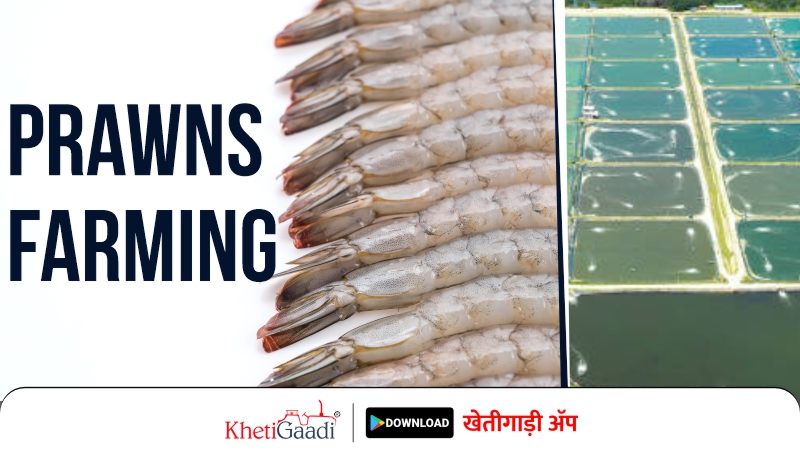Prawns farming, also known as aquaculture, is the practice of cultivating Prawns for human consumption or for use as bait. Prawn farming is a rapidly growing industry due to the high demand for Prawns worldwide.
There are two main types of Prawns farming: extensive and intensive. Extensive Prawns agriculture refers to a system of Prawns farming that utilizes large open areas such as ponds, lakes, or lagoons, where the Prawns are allowed to grow and reproduce naturally without much human intervention.
In extensive prawn farming, the natural ecosystem is utilized to the maximum extent possible. The Prawns are typically fed a combination of natural food sources such as plankton and other small organisms, as well as supplementary feeds like pellets or formulated diets. Water quality is carefully monitored to ensure the health and growth of the Prawns.
One of the advantages of extensive Prawns farming is its relatively low cost compared to intensive farming methods, where Prawns are raised in tanks or indoor facilities. However, extensive Prawns farming can also have drawbacks, such as the risk of disease outbreaks and environmental impacts, such as increased water pollution.
The success of extensive Prawns farming largely depends on factors such as the location of the farm, the quality of the water source, and the availability of suitable Prawns species for farming. Proper management practices and monitoring of environmental impacts can help ensure sustainable and profitable prawn farming operations.
Intensive Prawn farming, also known as shrimp farming, is a method of aquaculture where Prawns or shrimp are farmed in high-density environments with controlled conditions. This method of farming involves the use of artificial ponds or tanks, where the Prawns are raised on a commercial scale.
Intensive Prawns farming typically involves the use of a variety of technologies, including aerators, feeders, and water treatment systems, to ensure optimal growth conditions for the Prawns. The goal is to maximize yield and profit by producing large numbers of Prawns in a relatively small space.
While intensive Prawns farming can be highly profitable, it also has significant environmental impacts. The use of large amounts of antibiotics, pesticides, and other chemicals can lead to water pollution and damage to local ecosystems. Additionally, the high-density conditions in which the Prawns are raised can increase the risk of disease outbreaks, which can have devastating effects on entire populations of Prawns.
As with any form of agriculture, there are both benefits and drawbacks to intensive Prawns farming. It is essential to weigh these factors carefully when considering whether or not to invest in this method of aquaculture.
However, there are also potential environmental impacts associated with Prawns farming. These include the use of antibiotics and other chemicals, which can pollute the surrounding environment, and the potential for escaped Prawns to become invasive species in local waterways.
How to do Prawn farming?
Here are the steps to get started with Prawns farming:
1. Select a suitable location: Prawns farming requires flat, well-drained land that is close to a source of freshwater. The site should be free from pollution, strong currents, and waves.
2. Choose the right species: There are several Prawns species suitable for farming, including tiger Prawns, white Prawns, and giant river Prawns. Consult with a local expert to determine which species is best for your location.
3. Prepare the pond: Construct a pond that is suitable for Prawns farming. The pond should be deep enough to provide a suitable environment for Prawns to grow. You may need to line the pond with a waterproof material, such as plastic, to prevent water leakage.
4. Fill the pond with freshwater: Prawns require freshwater to survive, so fill the pond with clean, fresh water. You may need to treat the water to ensure it is suitable for Prawns.
5. Stock the pond: Once the pond is ready, introduce prawn seedlings into the pond. These can be obtained from a hatchery or another Prawns farmer.
6. Manage the pond: Prawns require regular monitoring and maintenance to ensure their survival and growth. This includes monitoring water quality, feeding the Prawns, and removing any dead or diseased Prawns.
7. Harvest the Prawns: When the Prawns have reached the desired size, they can be harvested using a seine net or a trap. The Prawns can be sold or consumed for personal use.
New technologies in prawn farming:
Let’s discuss the new technologies in prawn farming. In recent years there have been some new technologies have been introduced in prawn farming.
1. Biofloc technology: This is a system of farming that uses microbial communities to convert waste material into a valuable food source for Prawns. The microbes help to break down organic matter in the water and convert it into protein-rich flocs that can be consumed by Prawns.
2. Automated feeding systems: These systems use sensors and algorithms to automatically feed the Prawns based on their weight, age, and other factors. This reduces labour costs and ensures that the Prawns are getting the right amount of food.
3. Water treatment systems: New technologies in water treatment, such as ozone and UV disinfection, can help to maintain high water quality in Prawns farms. This can reduce disease outbreaks and improve the health of the Prawns.
4. Genetic selection: Advances in genetic selection techniques have made it possible to breed Prawns that are more resistant to disease, grow faster, and have better meat quality.
5. Recirculating aquaculture systems: These systems are designed to reuse water and minimize the amount of freshwater needed for Prawns farming. This can reduce the environmental impact of Prawns farming and make it more sustainable.
Why to choose Prawn farming?
There are several reasons to choose Prawns farming as a business or investment opportunity.
1. High Demand: Prawns are a highly sought-after seafood delicacy worldwide, and their demand is continuously increasing. Therefore, there is a potential for high returns on investment.
2. Versatility: Prawns can be consumed in various ways, such as in curries, salads, sandwiches, and as a standalone dish. Additionally, they are used as ingredients in various dishes, including sushi, soups, and stews.
3. High Growth Rate: Prawns have a high growth rate, and they reach maturity quickly, which means that you can have a fast turnaround time in your farming operations.
4. High Yield: Prawn farming has the potential to yield high volumes of Prawns in a relatively small area of land, making it an efficient farming method.
5. Sustainable: Prawn farming can be conducted using environmentally sustainable practices, such as utilizing recycled water, renewable energy sources, and organic feeds.
6. Economic Opportunities: Prawn farming provides economic opportunities for local communities and can be a source of employment for people in the surrounding areas.
Overall, Prawn farming is a lucrative and sustainable business opportunity that can provide significant returns on investment while contributing to the seafood industry’s growth.
Get information related to tractors, tractor videos, and tractor games; and visit the Khetiguru mobile application for farming-related updates.




